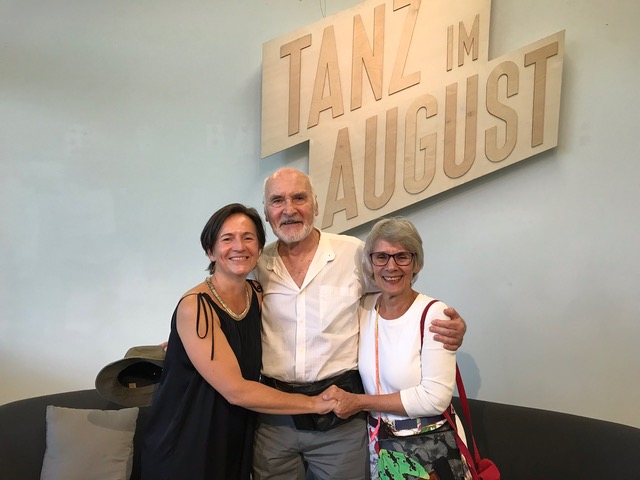The emergence of Tanzfabrik Berlin owes much to a network of roots that reaches deep into modern dance – and to a stable transatlantic network
Text: Heike Albrecht
I am not interested in searching, I am interested in finding.
Hellmut Gottschild
In 1978 the Tanzfabrik in Berlin-Kreuzberg created a new model of artistic production and performance practice for contemporary dance and its ongoing, often experimentally named renewal. Its founding marked the exemplary development of a contemporary dance scene, which from the beginning aimed at international networking and the establishment of a cross-generational dance education dedicated to radically new forms. In addition, numerous Tanzfabrik actors established important inner-city collaborations of a performance practice in Berlin, such as with the Akademie der Künste, the Theater am Halleschen Ufer or Tanz im August.
How did it begin?
The emergence of Tanzfabrik Berlin is closely linked to the development of dance modernism in the 20th century. In 1962, former students of Mary Wigman – Hellmut Gottschild, Brigitta Herrmann and Katharina Sehnert – founded the ensemble Motion in West Berlin, the first free, independent and collaboratively run dance company in divided post-war Germany. Motion performed in “Stunde des Tanzes” with Gerhard Bohner and found a permanent partner in Dirk Scheper at the Akademie der Künste. Improvisational strategies became significant for the ensemble, which Motion had become acquainted with through the guest performances of the Living Theater at the Akademie der Künste; the encounter with Merce Cunningham’s work; the understanding of Judson Dance Theater; and the influence of electronic music (Motion composer Thomas Kessler received the Art Prize of the City of Berlin in 1968). After previous “enemy formation”, from 1966 onwards all critics were enthusiastic about the approach and format formation of the post-expression dance generation, which was considered experimental and avant-garde in content and form and worked contrary to the established classical dance performance, the ballet. The careers of well-known dance artists are linked to Motion: Susanne Linke with her first performance, and Motion dancers Irene Sieben and Leonore Ickstedt, all three former Wigman students, were part of the production team.
Motion’s last piece development in Berlin, Countdown for Orpheus, premiered at the Akademie der Künste in 1967, can be described as the first local multi-media production. The use of film, live music and spoken live texts made thematic reference to the political present of the time and its social processes, such as the anti-Vietnam War movement, the student protests and the announcement of the moon landing. Nevertheless, Motion did not succeed in clearing the way for postmodern dance in Berlin.
After a press scandal, Hellmut Gottschild made it clear that there would be no further development for him and Motion in West Berlin and decided in 1968 to migrate artistically to the USA. He emigrated to Philadelphia with Brigitta Herrmann and Manfred Fischbeck and they began working there under the name Group Motion Multi Media Dance Theater. Performances at Judson Church in New York in 1968, at Jacob’s Pillow Dance Festival in 1969 and participation in the National Endowment for the Arts Touring Program made the group known in the USA. In 1972, Gottschild founded the Zero Dance Company, which he directed until 1992; Fischbeck and Herrmann in turn founded the Group Motion Workshop, which still takes place every Friday at the Community Education Center in West Philadelphia and has an offshoot in Berlin, at the Marameo, under the direction of former Group Motion dancers Heidi Weiss and Jennifer Man.
Back to West Berlin, Gottschild and his company were invited by the Akademie der Künste to give guest performances. The later founding of the Tanzfabrik is due to the constant exchange. Christine Vilardo, for example, came to West Berlin as a member of the Zero Moving Company with their invitation to the festival PMMT – Pantomime, Music, Dance, Theatre in 1976. She met Rainhardt Krätzig, a sports student and initiator of the courses Self-Experience through Movement at the Free University, who invited her to a workshop and made her stay in Berlin. Vilardo taught not only modern dance and improvisation, but also contact improvisation. The experiment of establishing these dance forms in Berlin and exploring new choreographic paths began with the search for spaces.
At the end of 1977, Reinhardt Krätzig identified an empty factory floor, an agreement was made with the owner, the pharmacy in Großbeerenstraße took over a guarantee and Studio1, the nucleus of the future Tanzfabrik, was created on an area of 180 square metres. The neighbouring 166 square metres were taken over by the residential community, whose changing members would go on to help shape the history of the Tanzfabrik.
It is thanks to the vision of Christine Vilardo and Rainhardt Krätzig, the support of the musician Heinz Zinsmeister, Petra Kugel and her husband Helmut Kugel, who has already passed away, that the first venue for contemporary dance in Berlin was able to come into being. The Tanzfabrik at Möckernstraße 68 in Berlin-Kreuzberg became “perhaps the most important centre for the development of a free contemporary dance scene in Germany” (Johannes Odenthal).
Published at Magazin tanzraumberlin 07-08.2018
www.tanzraumberlin.de
